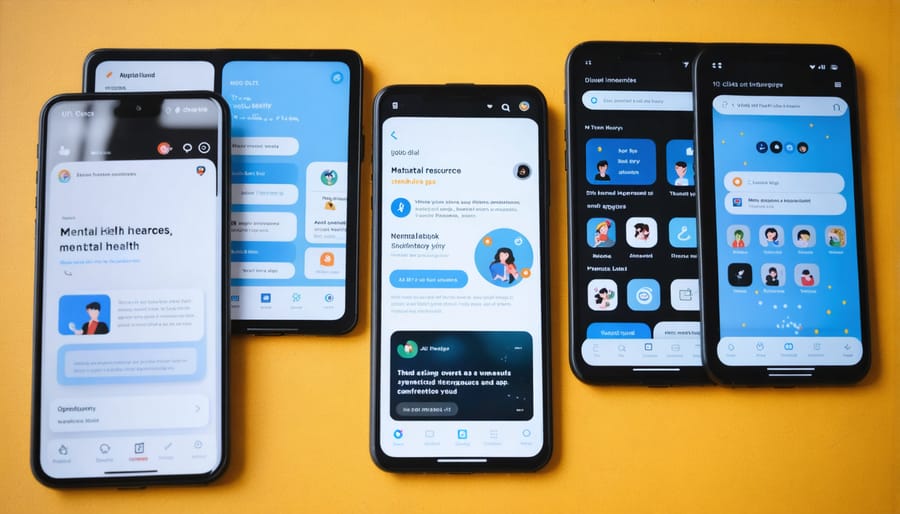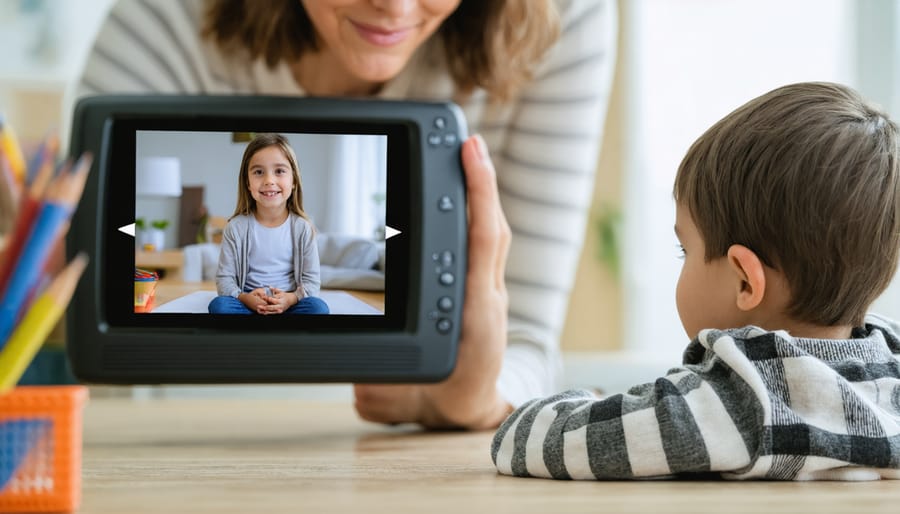Digital outreach transforms how we connect with young people struggling with mental health challenges. By meeting children and teens where they already spend significant time – in online spaces – we can bridge critical gaps in mental health support and create meaningful connections that save lives.
Recent studies show that 95% of teens have access to smartphones, making digital platforms an invaluable tool for mental health professionals, educators, and parents. Through carefully designed digital outreach programs, we can offer immediate support, reduce stigma, and create safe spaces for vulnerable youth to seek help on their terms.
The power of digital outreach lies in its accessibility and familiarity to young people. Whether through secure messaging apps, moderated online support groups, or interactive mental health resources, technology enables us to provide consistent, round-the-clock support that traditional face-to-face services cannot match. This approach particularly resonates with today’s youth, who often feel more comfortable initially expressing their struggles through digital channels.
However, effective digital outreach requires more than just technology – it demands a deep understanding of both adolescent mental health and digital safety. By combining clinical expertise with innovative digital solutions, we can create comprehensive support systems that protect privacy while fostering genuine connections and positive mental health outcomes for young people in need.
Let’s explore how digital outreach is revolutionizing mental health support and learn practical strategies for implementing these tools in our communities.
The Power of Digital Connection in Mental Health Support

Breaking Geographic Barriers
Digital platforms are revolutionizing how we access mental health support, breaking down traditional barriers of distance and location. Children in rural areas or those with limited transportation options can now connect with mental health professionals through secure video sessions from the comfort of their homes. This accessibility has been particularly transformative for families who previously had to travel long distances for in-person appointments.
For example, Sarah, a child therapist in Montana, now provides support to children across the entire state, including those in remote farming communities who previously had no access to specialized mental health services. “Technology has allowed us to reach children who would otherwise fall through the cracks,” she explains.
Digital outreach also enables continuous support through mobile apps, online support groups, and educational resources that are available 24/7. This means children can access help when they need it most, regardless of their geographic location or time zone. For families in underserved areas, these digital solutions provide essential mental health resources that were previously unavailable.
Additionally, digital platforms allow for culturally appropriate care by connecting children with professionals who understand their specific background and needs, even if they’re not locally available.
Creating Safe Spaces Online
Creating safe online spaces for children requires a thoughtful balance of structure and freedom. Children need environments where they can express themselves openly while feeling protected and supported. This often means establishing clear guidelines and boundaries while maintaining a welcoming atmosphere.
Digital platforms specifically designed for youth mental health support typically include features like moderated chat rooms, peer support forums, and private messaging options with trusted counselors. These spaces incorporate age-appropriate content filters and robust privacy settings to ensure children’s safety while allowing them to connect with others who share similar experiences.
As Dr. Sarah Chen, a child psychologist, explains, “When children feel safe online, they’re more likely to open up about their struggles and seek help when needed. The key is creating spaces that feel both secure and inviting.”
Parents and educators can help by establishing designated “digital safe zones” – monitored online areas where children can interact, share their thoughts, and receive support. This might include supervised video chat sessions, moderated group activities, or structured online support groups led by mental health professionals.
Remember that safe spaces should evolve with children’s needs, incorporating their feedback and adapting to their changing emotional requirements.
Essential Digital Outreach Tools and Platforms
Virtual Support Groups
Virtual support groups provide a safe, accessible space for children and teens to connect with peers who share similar experiences and challenges. These online communities, facilitated by trained mental health professionals, offer structured discussions and activities that promote emotional well-being and social connection.
Many platforms now host age-appropriate group sessions where young people can share their feelings, learn coping strategies, and build meaningful relationships. Parents report that their children feel more comfortable opening up in these digital spaces, often expressing themselves more freely than they might in traditional face-to-face settings.
“I’ve seen remarkable progress in children who participate in our virtual groups,” shares Dr. Sarah Chen, a child psychologist. “The digital format actually helps some kids feel less self-conscious and more willing to engage.”
These groups typically include activities like guided discussions, creative expression exercises, and skill-building workshops. Moderators ensure a supportive environment while maintaining strict safety protocols. Some groups focus on specific challenges like anxiety or social skills, while others provide general emotional support and community building.
For families in remote areas or those with busy schedules, virtual support groups offer flexibility and eliminate transportation barriers, making mental health support more accessible than ever.
Educational Resources and Apps
In today’s digital age, numerous educational resources and mental health applications are available to support children’s emotional well-being and development. Popular learning platforms like Khan Academy and BrainPOP offer engaging content that helps children understand mental health concepts in age-appropriate ways. These resources often include interactive games, animated videos, and guided activities that make learning about emotional awareness and coping strategies fun and accessible.
Many schools have adopted digital tools like ClassDojo and Calm Kids, which help track emotional progress and teach mindfulness techniques. These platforms allow teachers and parents to work together in supporting children’s mental health journey. As Sarah Chen, a school counselor in Boston, shares, “Digital tools have transformed how we reach students. They’re more likely to engage with mental health content when it’s presented through familiar technology.”
For younger children, apps like Breathe, Think, Do with Sesame and Mindful Powers provide gentle introductions to emotional regulation through storytelling and simple exercises. Older students benefit from more sophisticated tools that offer mood tracking, guided journaling, and anonymous peer support features. When selecting resources, it’s essential to choose age-appropriate options that align with your child’s needs and comfort level with technology.


Teletherapy Platforms
Teletherapy platforms have revolutionized how children and families access mental health support, making professional help more accessible than ever. These digital solutions offer secure video sessions, messaging features, and interactive tools that create a comfortable environment for young clients to express themselves.
Popular platforms like BetterHelp Kids, TalkSpace Youth, and Growing Minds Online provide specialized services tailored to children’s needs. Each platform carefully matches young clients with licensed therapists who have expertise in child and adolescent mental health. The benefits of virtual therapy include flexible scheduling, reduced travel time, and the ability to connect from familiar surroundings – factors that can make therapy less intimidating for children.
“Many of my young clients actually prefer virtual sessions,” shares Dr. Sarah Chen, a child psychologist. “They’re already comfortable with technology, and being in their own space helps them open up more freely.”
These platforms also offer parent resources, progress tracking, and secure communication channels between sessions. Some even incorporate interactive elements like therapeutic games and art tools that enhance engagement. When choosing a platform, look for those with strong privacy measures, age-appropriate interfaces, and therapists specifically trained in youth counseling.
Making Digital Outreach Work for Your Child
Safety and Privacy Considerations
When implementing digital outreach programs, maintaining safety and privacy should be the top priority. Understanding digital safety for kids is crucial for creating a secure environment where young people feel comfortable seeking help.
Always use secure, encrypted platforms for communication and ensure that all digital interactions are documented and monitored appropriately. Establish clear boundaries for online engagement, including specific hours of availability and emergency protocols. It’s essential to have trained professionals overseeing digital communications and maintaining strict confidentiality standards.
Consider implementing these key safety measures:
– Use age-appropriate platforms and tools
– Obtain parental consent for minors
– Establish clear communication guidelines
– Monitor all digital interactions
– Keep detailed records of online sessions
– Have emergency response protocols in place
Privacy protection should include secure data storage, limited access to sensitive information, and regular security audits. Train staff members on proper data handling procedures and ensure they understand the importance of maintaining confidentiality in digital spaces.
Remember to regularly update safety protocols as technology evolves and new challenges emerge. Creating a safe digital environment helps build trust and encourages those seeking support to engage more openly with mental health resources.
Creating a Balanced Approach
Creating an effective support system requires thoughtfully combining digital and traditional approaches. As Dr. Sarah Chen, a child psychologist, explains, “The key is not choosing between digital or traditional methods, but finding ways they can complement each other.”
Start by assessing your child’s comfort level with technology and their specific needs. Some children may respond better to face-to-face interactions, while others might feel more comfortable opening up through digital platforms. The goal is to create a supportive environment that leverages the strengths of both approaches.
Consider implementing a hybrid approach where digital tools enhance traditional support methods. For example, use meditation apps to reinforce coping strategies learned during in-person sessions, or maintain a digital mood journal to track progress between face-to-face meetings. Understanding balancing screen time and mental health is crucial for creating this integrated approach.
Here are practical tips for achieving this balance:
– Schedule regular in-person check-ins alongside digital communication
– Use technology to maintain connection between face-to-face meetings
– Set clear boundaries for digital tool usage
– Choose apps and platforms that complement traditional therapeutic techniques
– Monitor progress through both personal observation and digital tracking
Remember that flexibility is key – what works for one child may not work for another. Regular evaluation and adjustment of your approach ensures the best possible support for your child’s mental health journey.
Future of Digital Mental Health Support
The landscape of digital mental health support is rapidly evolving, bringing exciting innovations that promise to make mental health care more accessible and engaging for children and young people. Artificial Intelligence and machine learning are paving the way for more personalized support experiences, with chatbots and virtual assistants becoming increasingly sophisticated in recognizing emotional cues and providing appropriate responses.
Virtual reality (VR) and augmented reality (AR) technologies are emerging as powerful tools for therapy and emotional learning. These immersive experiences allow children to practice coping strategies in safe, controlled environments. For example, a child with social anxiety might use VR to gradually practice social interactions, building confidence before facing real-world situations.
Dr. Sarah Martinez, a child psychologist specializing in digital therapeutics, shares, “We’re seeing remarkable progress in how technology can complement traditional therapy. The future lies in creating hybrid models that combine the best of both digital and in-person support.”
Wearable technology is another promising frontier, with devices that can track stress levels, sleep patterns, and emotional states. This data helps both caregivers and mental health professionals provide more targeted and timely support. Smart watches and bio-sensing clothing are being developed specifically for children, with engaging interfaces that help them understand and manage their emotions.
Mobile apps are becoming more sophisticated, incorporating gamification elements that make mental health support feel less clinical and more engaging. These apps are increasingly using peer support features, allowing young people to connect safely with others who share similar experiences.
Looking ahead, we can expect to see more integration between different digital platforms, creating comprehensive support ecosystems. This might include school-based programs that connect seamlessly with home support systems, ensuring consistent care across all aspects of a child’s life.
However, as these technologies advance, the focus remains on maintaining human connection at the core of mental health support. The goal is to use technology as a tool to enhance, rather than replace, meaningful human interactions and professional support.
In today’s digital age, the opportunities for supporting children’s mental health through technology have never been more promising or accessible. As we’ve explored throughout this article, digital outreach provides flexible, engaging, and effective ways to connect children with the mental health support they need.
Remember that digital tools aren’t meant to replace traditional face-to-face support but rather to complement existing resources and expand access to care. Whether through mobile apps, online counseling platforms, or educational games, these digital solutions can help bridge gaps in mental health support and create more comfortable spaces for children to express themselves.
For parents considering digital mental health support for their children, start small and explore options together. Talk with your children about their preferences and comfort levels with different digital tools. Many platforms offer free trials or basic versions, allowing you to test what works best for your family before making any commitments.
Don’t forget to prioritize safety and privacy when choosing digital mental health resources. Look for platforms with strong security measures, age-appropriate content, and professional oversight. Consider consulting with your child’s healthcare provider or school counselor for recommendations on reputable digital mental health tools.
The future of children’s mental health support increasingly includes digital components, and staying informed about these options can help you make the best choices for your child’s wellbeing. By embracing these technological advances while maintaining a balanced approach, we can help ensure our children have access to the support they need, when and where they need it most.
Take the first step today by exploring some of the digital resources mentioned in this guide. Your child’s mental health journey may be significantly enhanced by the right combination of traditional and digital support.


